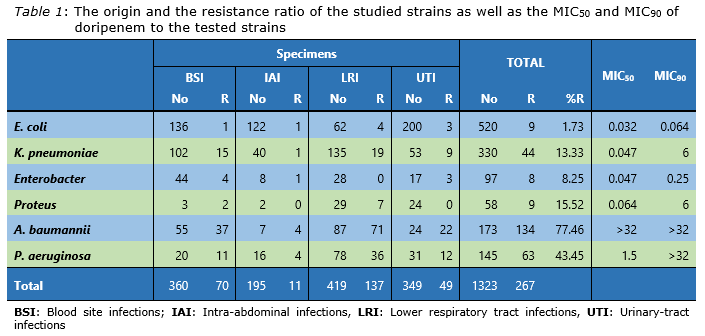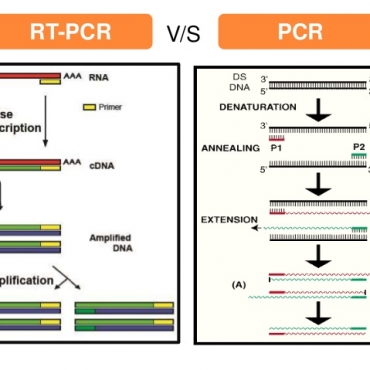Contact Admission
The resistance of the gram-negative rods isolated from clinical cases in Vietnam to doripenem
4Pham Ngoc Thach University of Medicine, 5Phan Chau Trinh University
BACKGROUND
In Vietnam, there have been many studies on the resistance of clinical isolated Gram [-] rods to imipenem and meropenem. For doripenem, the COMPACT II was recently reported as a multinational study investigating the doripenem resistance of gram negative rods isolated from hospitals in many countries in Asia, including Vietnam. However, the resistant data received from COMPACT II related to Vietnam was based on the quite small amount of isolates, so it is difficult to accurately reflect the in vitro efficacy of doripenem on the clinical isolate.
AIMS
Investigate the situation of the resistance to doripenem of the high number of gram negative rods collected from different hospital in Vietnam and these strains were isolated from inpatients with infections.
MATERIALS – METHODS
The objects of the study are the facultative Gram-negative rods including E. coli, K. pneumoniae, Proteus, Enterobacter, P. aeruginosa, and A. baumannii isolated from different infections including septicemia (BSI), urinary tract infection (UTI), intra-abdominal infections (IAI) and lower respiratory tract infection (LRI). The strains were collected from different hospital in Hochiminh city and in Hanoi. The method of susceptibility testing was the determination of MIC using Etest (Biomerieux) and the procedure was followed the manufacturer. The E. coli ATCC 25922 and P. aeruginosa ATCC 27853 were used to quality control. The interpretation standard of CLSI 2016 was used to interpret the received results of MIC. Beside Etest, the synergistic effect of the combination doripenem+colistin and doripenem+tigecycline on the XDR A. baumannii was also investigated and the method for this testing was the chess-board procedure on the 96 micro-well plate.
RESULTS - DISCUSSIONS
From June 2015 to March 2016, 1323 isolates were collected and involved in the study. These strains included 520 E. coli, 330 K. pneumoniae, 97 Enterobacter, 58 Proteus, 173 A. baumannii, and 145 P. aeruginosa. The origin of the strains were isolated from in-patients with different infections including septicemia (360), intra-abdominal infection (195), lower respiratory tract infection (419) and urinary tract infection (349).
The received results of doripenem MIC showed that 7% of Enterobacteriaceae were resistant to doripenem with MIC50 and MIC90 was 0.032µg/ml and 0.25µg/ml, respectively. The ratio of doripenem resistance of P. aeruginosa was 43.5% with MIC50 và MIC90 were 1.5 and 32µg/ml, respectively. The ratio of doripenem resistance of A. baumannii was 77.5% với MIC50 and MIC90 was over 32µg/ml.
The origin and the resistance ratio of the studied strains as well as the MIC50 and MIC90 of doripenem to the tested strains were demonstrated in detail in table 1.
There were 118 strains of A. baumannii with XDR were selected from the study to enter the investigation of the synergistic effect of two antibiotic combinations; doripenem+colistin and doripenem+tigecycline. The received results showed that the combination of doripenem+colistin gave the synergistic effect on 89.8% of MDR A. baumannii, and the synergistic effect of doripenem+tigecycline was 83.9%. There were 100% of A. baumannii resistance to doripenem became sensible to doripenem if the concentration of colistin was 2µg/ml in the combination, and this ratio decreased to 42.3% if the concentration of colistin was 1µg/ml, to 35.1% if the concentration of colistin was 0.5µg/ml, and to 6.6% if the concentration of colistin was 0.25µg/ml. The study also reported that 16.2% of A. baumannii resistance to doripenem became sensible to doripenem if the synergistic effect existed in the combination doripenem+tigecycline.

CONCLUSION
This study can be considered as the first study to investigate the resistance to doripenem of the high number of Gram negative rods isolated from in-patients with septicemia, intra-abdominal infection, urinary tract infection and lower respiratory tract infection in Vietnam. The received and analyzed results were the essential data and information for clinical to consider selecting the appropriate antibiotic for treatment of infections causing by the Gram-negative rods.
Other research
- Rapid and sensitive diagnostic procedure for multiple detection of pandemic Coronaviridae family members SARS-CoV-2, SARS-CoV, MERS-CoV and HCoV: a translational research and cooperation between the Phan Chau Trinh University in Vietnam and Universit ( 15:42 - 29/06/2020 )
- PCTU studies at ISSAR 2019 international conference - Gyeongju, Korea ( 16:17 - 04/11/2019 )
- Melioidosis in Vietnam: Recently Improved Recognition but still an Uncertain Disease Burden after Almost a Century of Reporting ( 13:29 - 27/04/2018 )
- Microbiological agents causing community pneumonia require hospitalization ( 11:20 - 03/02/2018 )
- The in-vitro activity of sitafloxacin against the most common bacterial pathogens isolated from the clinical samples ( 11:10 - 03/02/2018 )
- Evaluate the role of the microbiological molecular biology tests in the early detection of pathogens causing lower respiratory infections ( 10:52 - 03/02/2018 )
- Production and evaluation of the kit using magnetic silica coated nano-iron beads to extract the nucleic acid from different samples ( 10:16 - 03/02/2018 )
- Challenges in selecting antibiotics treatment for H. Pylori in Vietnam ( 09:12 - 03/02/2018 )









